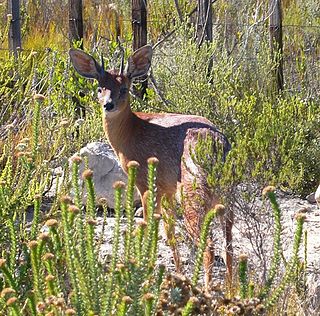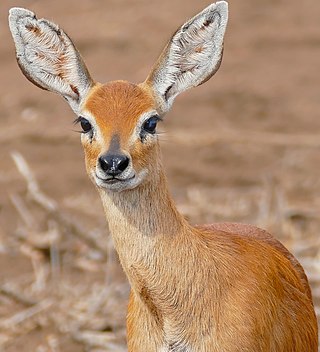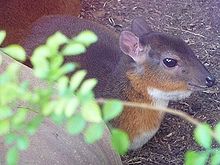
The term antelope is used to refer to many species of even-toed ruminant that are indigenous to various regions in Africa and Eurasia.

The Bovidae comprise the biological family of cloven-hoofed, ruminant mammals that includes cattle, bison, buffalo, antelopes, and caprines. A member of this family is called a bovid. With 143 extant species and 300 known extinct species, the family Bovidae consists of 11 major subfamilies and thirteen major tribes. The family evolved 20 million years ago, in the early Miocene.

The klipspringer is a small antelope found in eastern and southern Africa. The sole member of its genus and subfamily/tribe, the klipspringer was first described by German zoologist Eberhard August Wilhelm von Zimmermann in 1783. The klipspringer is a small, sturdy antelope; it reaches 43–60 centimetres at the shoulder and weighs from 8 to 18 kilograms. The coat of the klipspringer, yellowish gray to reddish brown, acts as an efficient camouflage in its rocky habitat. Unlike most other antelopes, the klipspringer has a thick and coarse coat with hollow, brittle hairs. The horns, short and spiky, typically measure 7.5–9 cm.

A dik-dik is the name for any of four species of small antelope in the genus Madoqua that live in the bushlands of eastern and southern Africa.

The royal antelope is a West African antelope recognized as the world's smallest antelope. It was first described by Swedish zoologist Carl Linnaeus in 1758. It stands up to merely 25 cm (10 in) at the shoulder and weighs 2.5–3 kg (5.5–6.6 lb). A characteristic feature is the long and slender legs, with the hindlegs twice as long as the forelegs. Horns are possessed only by males; the short, smooth, spiky horns measure 2.5–3 cm (0.98–1.18 in) and bend backward. The soft coat is reddish to golden brown, in sharp contrast with the white ventral parts. In comparison to Bates's pygmy antelope, the royal antelope has a longer muzzle, broader lips, a smaller mouth and smaller cheek muscles.

The Antilopines are even-toed ungulates belonging to the subfamily Antilopinae of the family Bovidae. The members of tribe Antilopini include the gazelles, blackbucks, springboks, gerenuks, dibatags, and Central Asian gazelles, are often referred to as true antelopes. True antelopes occur in much of Africa and Asia, with the highest concentration of species occurring in East Africa in Sudan, Eritrea, Ethiopia, Somalia, Kenya, and Tanzania. The saigas and Tibetan antelopes inhabit much of central and western Asia. The dwarf antelopes of tribe Neotragini live entirely in sub-Saharan Africa.

The oribi is a small antelope found in eastern, southern and western Africa. The sole member of its genus, it was described by the German zoologist Eberhard August Wilhelm von Zimmermann in 1783. While this is the only member in the genus Ourebia, eight subspecies are identified. The oribi reaches nearly 50–67 centimetres (20–26 in) at the shoulder and weighs 12–22 kilograms (26–49 lb). It possesses a slightly raised back, and long neck and limbs. The glossy, yellowish to rufous brown coat contrasts with the white chin, throat, underparts and rump. Only males possess horns; the thin, straight horns, 8–18 centimetres (3.1–7.1 in) long, are smooth at the tips and ringed at the base.

Kirk's dik-dik is a small antelope native to Eastern Africa and one of four species of dik-dik antelope. It is believed to have six subspecies and possibly a seventh existing in southwest Africa. Dik-diks are herbivores, typically of a fawn color that aids in camouflaging themselves in savannah habitats. According to MacDonald (1985), they are also capable of reaching speeds up to 42 km/hour. The lifespan of Kirk's dik-dik in the wild is typically 5 years, but may surpass 10 years. In captivity, males have been known to live up to 16.5 years, while females have lived up to 18.4 years.
The silver dik-dik is a small antelope found in low, dense thickets along the southeastern coast of Somalia and in Acacia-Commiphora bushland in the Shebelle Valley in southeastern Ethiopia. It is the smallest species of dik-dik, with a length of 45–50 cm (18–20 in), a height of 30–33 cm (12–13 in), and a weight of 2–3 kg (4.4–6.6 lb). Its back and flanks are grizzled silvery, while the limbs, ears, and muzzle are ochraceus in colour. Little is known about its status, but numbers are believed to be decreasing.

Sharpe's or northern grysbok is a small, shy, solitary antelope that is found from tropical to south-eastern Africa.

The Cape or southern grysbok is a small antelope that is endemic to the Western Cape region of South Africa between Albany and the Cederberg mountains.
Grysbok may refer to the following species of African antelope:

Raphicerus is a genus of small antelopes of the tribe Neotragini.

Salt's dik-dik is a small antelope found in semidesert, bushland, and thickets in the Horn of Africa, but marginally also in northern Kenya and eastern Sudan. It is named after Henry Salt, who was the first European to acknowledge the species in Abyssinia in the early 19th century.

Günther's dik-dik is a small antelope found in arid zones of East Africa.

The wildlife of Namibia is composed of its flora and fauna. Namibia's endangered species include the wild dog, black rhino, oribi and puku.

The preorbital gland is a paired exocrine gland found in many species of hoofed animals, which is homologous to the lacrimal gland found in humans. These glands are trenchlike slits of dark blue to black, nearly bare skin extending from the medial canthus of each eye. They are lined by a combination of sebaceous and sudoriferous glands, and they produce secretions which contain pheromones and other semiochemical compounds. Ungulates frequently deposit these secretions on twigs and grass as a means of communication with other animals.
Malka Mari National Park is a national park of Kenya, situated along the Dawa River on the Kenya-Ethiopia border. It is approximately 1,500 square kilometres in size. It is accessible via the Mandera Airport, and is probably the least visited national park in the nation.














